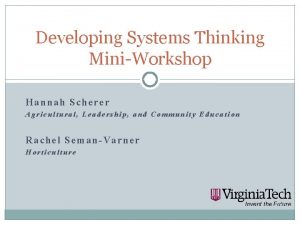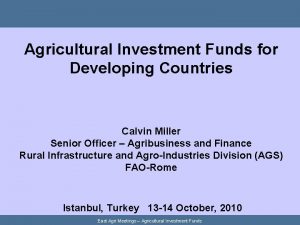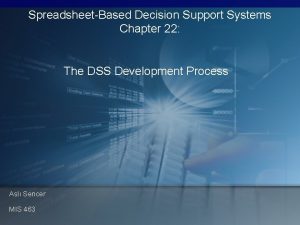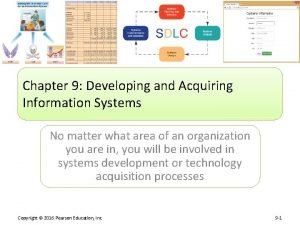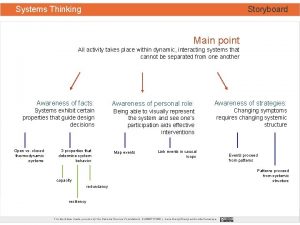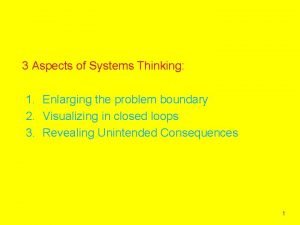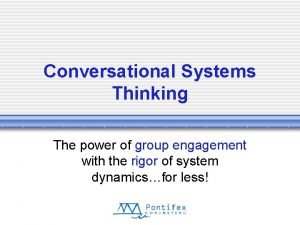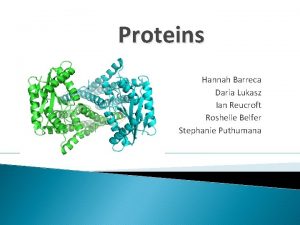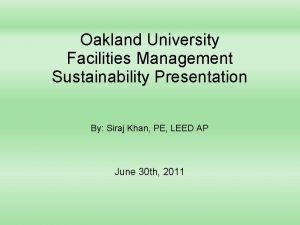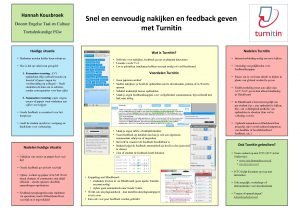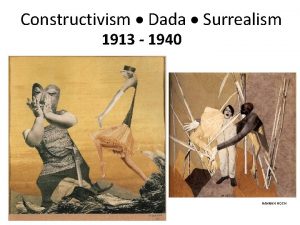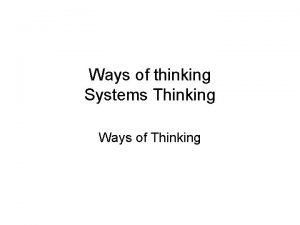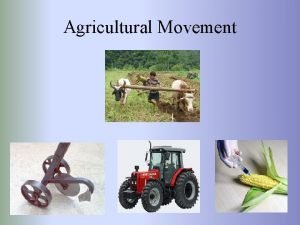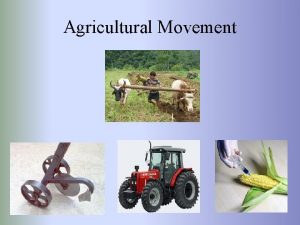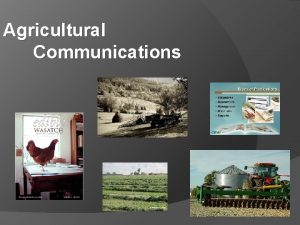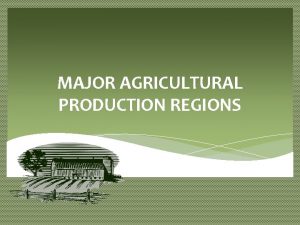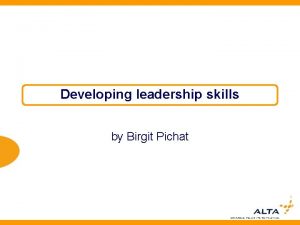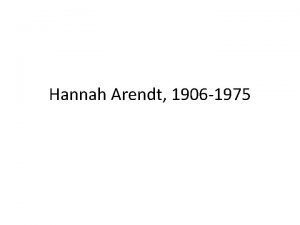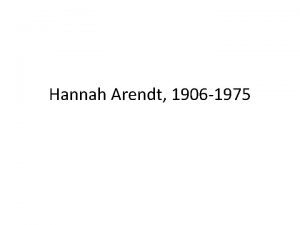Developing Systems Thinking MiniWorkshop Hannah Scherer Agricultural Leadership








































- Slides: 40

Developing Systems Thinking Mini-Workshop Hannah Scherer Agricultural, Leadership, and Community Education Rachel Seman-Varner Horticulture

Workshop goals By the end of this workshop, you will: �be able to explain the ways in which scientists approach complex systems �have a collection of resources and strategies for teaching systems thinking

Overview of Workshop Part 1: Guided exploration of a complex system �Student Hat – interactive lesson �Teacher Hat – debrief of lesson Part 2: Exploration of resources Part 3: Flex time or Q & A

Part 1: Exploring complex systems http: //www. shiftn. com/obesity/Full-Map. html

Put on your “Student Hat”

In your group, answer the following questions: What is a system? What do you think makes a system different from a bunch of stuff?

What do you see in this photo? Photo by Dawn Ellner (CC BY 2. 0)

What do you see in this photo? Photo by Genthar (CC BY-NC-ND Photo djmapleferryman 2. 0) Photo byby Jason Morrison (CC(CC BYBY NC-2. 0)

In your group (10 minutes) �Pick an element from the list �Research your element www. monolake. org is a good place to start �Prepare to explain your element to others (highlights)

In your new group (10 minutes) �Write the name of each element on a post-it �Connect elements that you think are related �Label your connections with processes you think may relate the two elements �You have just created a diagram of a part of the Mono Lake system. What do you think is its function? Tufa towers Water

What is a system? Elements (e. g. water, brine shrimp) Interconnections (e. g. salinity) Function (e. g. healthy bird population)

On your own, answer the following question: What is the biggest question you have about this system right now?

Put on your “Teacher Hat”

In your group, discuss �What expertise or prior knowledge did you bring to the activity? Did this play a role in your thinking? �What do you think would be confusing for your students? What could you do to alleviate that confusion? �If you were teaching this lesson, what would you do next?

Key considerations in planning Consider how systems thinking is used in your (inter)disciplinary context Define learning goals related to both content and process (systems thinking) Identify potential points of confusion and plan for how you will break them down Activities, assessments, projects, etc. Scaffold systems thinking concepts along with science concepts Incorporate use of systems language explicitly

“Basic” systems thinking components �Boundaries (open vs. closed systems) �Multiple interacting parts/ spheres �Perturbations can impact other parts of system �Multiple causal factors can influence one outcome http: //serc. carleton. edu/integrate/teaching_materials/systems_what. html

“Trickier” systems thinking components �Positive and negative feedback loops �Exchange of matter or energy (flux) �Reservoir �Residence time �Lag (delay) �Tipping point/ limit (threshold) http: //serc. carleton. edu/integrate/teaching_materials/systems_what. html

“Advanced” systems thinking components �Emergent properties �Non-linear change �Resilience �Static vs. dynamic systems http: //serc. carleton. edu/integrate/teaching_materials/systems_what. html

Check in with yourself (5 minute quick write) What is your biggest “a-ha” so far? What ideas have you had about teaching systems in your own classes? What are your biggest questions at this point?

Part 2: Resource Exploration �Break included �Choose your own adventure Partner with a colleague with a similar interest Look for new ideas for teaching a concept using systems thinking Research a specific systems topic in more depth Look at examples of systems-based teaching approaches Explore resources and see where you land Others? �Post to the Teaching Systems workspace

Part 3: Flex time – what do you need now?

Assignment Critique �Please answer the following questions for each assignment (assignments 1 and 2) What do you like about the assignment? What don’t you like about the assignment? What would you change about the assignment to improve students’ understanding of systems?

Unit 5: Predicting the effects of climate change on soil loss http: //serc. carleton. edu/integrate/teaching_materials/sustain_agriculture/activity 5. html

The relationship between precipitation and soil erosion is a complex system. Estimated average soil loss = R*K*LS*C*P

The relationship between precipitation and soil erosion is a complex system. Precipitatio n ? Erosion

This diagram illustrates relationships between factors that influence erosion in agricultural systems. Runoff + + Precipitatio n + - Erosion Crop Yield Modified from: Pruski, F. F. , and M. A. Nearing, 2002, Climate-induced changes in erosion during the 21 st century for eight U. S. locations, Water Resour. Res. , 38(12), 1298, doi: 10. 1029/2001 WR 000493.

The direction of the arrows indicates cause and effect relationships. Runoff Precipitatio n Erosion Crop Yield (diagram modified from Pruski and Nearing, 2002)

For example, this arrow tells us that changes in precipitation cause changes in runoff. Runoff Precipitatio n (diagram modified from Pruski and Nearing, 2002)

If it were pointing the other way, that would mean that changes in runoff cause changes in precipitation. This doesn’t make much sense! Runoff X Precipitatio n (diagram modified from Pruski and Nearing, 2002)

But, the direction of the arrows doesn’t tell us how a factor impacts other factors. Runoff Precipitatio n Erosion Crop Yield (diagram modified from Pruski and Nearing, 2002)

The + and – signs indicate what type of relationship exists between the factors. + = positive relationship - = negative relationship Runoff + + Precipitatio n + - Erosion Crop Yield (diagram modified from Pruski and Nearing, 2002)

A positive relationship means that a change in one factor causes an effect on another factor in the same direction. Runoff + Precipitatio n + + Erosion Crop Yield (diagram modified from Pruski and Nearing, 2002)

For example, this arrow indicates that… an increase in precipitation causes an increase in runoff AND a decrease in precipitation causes a decrease in runoff Runoff + Precipitatio n (diagram modified from Pruski and Nearing, 2002)

A negative relationship means that a change in one factor causes an effect on another factor in the opposite direction. Runoff - Erosion Crop Yield (diagram modified from Pruski and Nearing, 2002)

For example, this arrow indicates that… an increase in crop yield causes a decrease in erosion AND a decrease in crop yield causes an increase in erosion Erosion Crop Yield (diagram modified from Pruski and Nearing, 2002)

So, we can use this diagram to describe relationships between factors that influence erosion in agricultural systems and predict how changes in one factor will influence other factors. Runoff + + Precipitatio n + - Erosion Crop Yield (diagram modified from Pruski and Nearing, 2002)

Models for Syracuse, Nebraska, predict that precipitation will decrease overall for the region. Erosion is also expected to decrease for wheat. Which pathway is most likely to be dominant for wheat? Runoff + + Precipitatio n + - Erosion Crop Yield (diagram modified from Pruski and Nearing, 2002)

The same models predict that, while precipitation decreases overall for the region, erosion is expected to increase for cornfields. Which pathway is most likely to be dominant for corn? Runoff + + Precipitatio n + - Erosion Crop Yield (diagram modified from Pruski and Nearing, 2002)

Based on these pathways, which crop do you think is more severely impacted by the decrease in precipitation? Wheat Runoff + + Precipitatio n + Corn - Erosion Crop Yield (diagram modified from Pruski and Nearing, 2002)

In agricultural systems, humans also make decisions that can have big impacts. What are some ways in which humans influence agriculture?
 Dr. hannah scherer
Dr. hannah scherer Dr hannah scherer
Dr hannah scherer Hannah scherer
Hannah scherer Calvin miller coltivare
Calvin miller coltivare Ingrid scherer
Ingrid scherer Looper cicd
Looper cicd Andreas scherer
Andreas scherer Medtronic organizational chart
Medtronic organizational chart Developing your leadership philosophy download
Developing your leadership philosophy download Developing a leadership philosophy
Developing a leadership philosophy Developing your leadership philosophy classes
Developing your leadership philosophy classes Developing spreadsheet-based decision support systems
Developing spreadsheet-based decision support systems Acquiring information systems and applications
Acquiring information systems and applications Positive thinking vs negative thinking examples
Positive thinking vs negative thinking examples Thinking about your own thinking
Thinking about your own thinking Holistic thinking example
Holistic thinking example Perbedaan critical thinking dan creative thinking
Perbedaan critical thinking dan creative thinking Thinking about you thinking about me
Thinking about you thinking about me Transactional leadership vs transformational leadership
Transactional leadership vs transformational leadership What is adaptive leadership style
What is adaptive leadership style Capable but cautious performer
Capable but cautious performer Systems thinking tools
Systems thinking tools Aspects of systems thinking
Aspects of systems thinking Barry richmond systems thinking
Barry richmond systems thinking Catholic woman
Catholic woman What are the geriatric giants
What are the geriatric giants Hannah stailey
Hannah stailey Hannah burrack
Hannah burrack Daria lukasz
Daria lukasz Hannah poore
Hannah poore Hannah hall oakland university
Hannah hall oakland university Ruthy hannah pearce
Ruthy hannah pearce Hannah hernan cortes actress
Hannah hernan cortes actress Hannah kousbroek
Hannah kousbroek Hannah m hutchison
Hannah m hutchison Hannah xavier
Hannah xavier Hannah kreinsen
Hannah kreinsen Russian surrealism
Russian surrealism Hannah isherwood
Hannah isherwood Hannah bosley
Hannah bosley Stevie wonder car accident
Stevie wonder car accident
